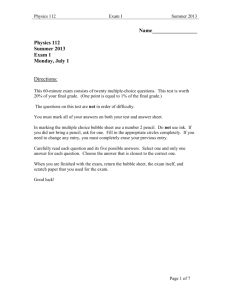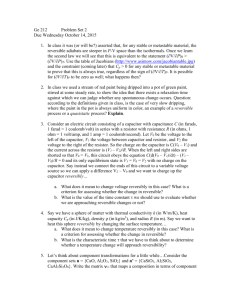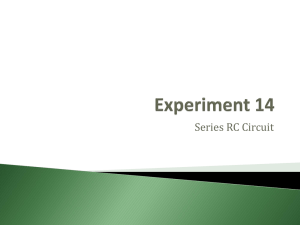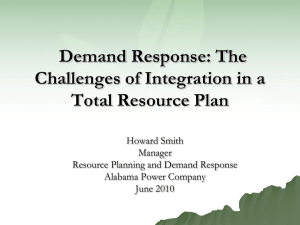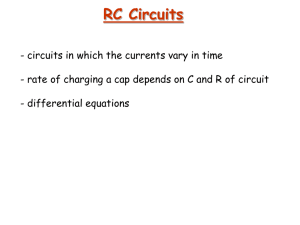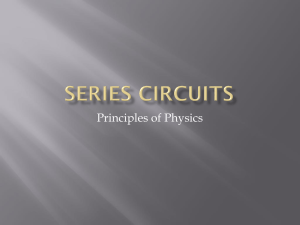exam1_solutions
advertisement
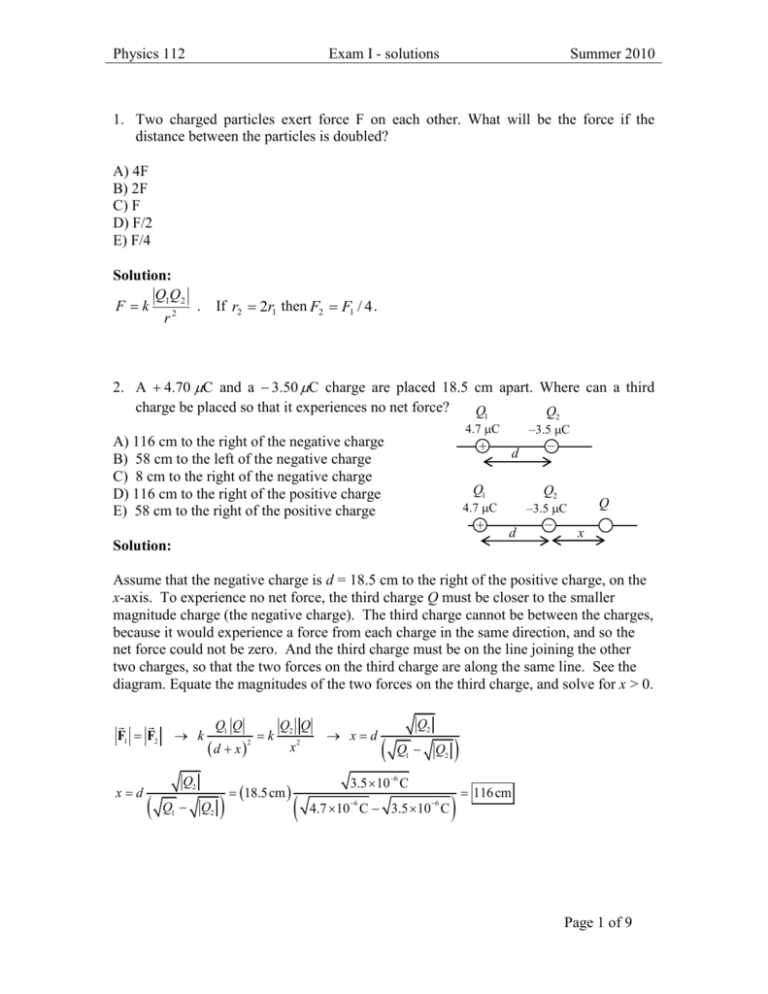
Physics 112 Exam I - solutions Summer 2010 1. Two charged particles exert force F on each other. What will be the force if the distance between the particles is doubled? A) 4F B) 2F C) F D) F/2 E) F/4 Solution: Q1Q2 F k . r2 If r2 2r1 then F2 F1 / 4 . 2. A 4.70 C and a 3.50 C charge are placed 18.5 cm apart. Where can a third charge be placed so that it experiences no net force? Q1 Q2 4.7 C A) 116 cm to the right of the negative charge B) 58 cm to the left of the negative charge C) 8 cm to the right of the negative charge D) 116 cm to the right of the positive charge E) 58 cm to the right of the positive charge –3.5 C + d Q1 Q2 4.7 C + – Q –3.5 C d – x Solution: Assume that the negative charge is d = 18.5 cm to the right of the positive charge, on the x-axis. To experience no net force, the third charge Q must be closer to the smaller magnitude charge (the negative charge). The third charge cannot be between the charges, because it would experience a force from each charge in the same direction, and so the net force could not be zero. And the third charge must be on the line joining the other two charges, so that the two forces on the third charge are along the same line. See the diagram. Equate the magnitudes of the two forces on the third charge, and solve for x > 0. F1 F2 xd k Q1 Q d x Q2 Q1 Q2 2 k Q2 Q x 18.5cm 2 xd Q2 Q1 Q2 3.5 106 C 6 6 4.7 10 C 3.5 10 C 116 cm Page 1 of 9 Physics 112 Exam I - solutions Summer 2010 3. Three positive particles of equal charge, 11.0 C, are located at the corners of an equilateral triangle of side 15.0 cm. Calculate the magnitude of electric field at the center of the triangle. A) 83.7 N/C B) 7.6 N/C C) 3.8 N/C D) 0.69 N/C E) 0 Solution: Becouse of symmetry: E E1 E2 E3 0 . Q2 E3 E1 E2 Q1 Q3 4. Calculate the magnitude of electric field at one corner of a square 1.00 m on a side if the other three corners are occupied by 2.25 10 6 C charges. E3 A) 1.8 10 4 N / C B) 3.9 10 4 N / C C) 7.8 10 4 N / C D) 4.5 10 5 N / C E) 6.5 10 5 N / C E2 Q1 E1 d Q2 Solution: Q3 The field at the upper right corner of the square is the vector sum of the fields due to the other three charges. Let the variable d represent the 1.0 m length of a side of the square, and let the variable Q represent the charge at each of the three occupied corners. Q Q E1 k 2 E1x k 2 , E1 y 0 d d E2 k E3 k Q 2d Q d 2 2 E2 x k Q 2d 2 cos45o k E3 x 0 , E1 y k 2Q 4d 2 , E2 y k 2Q 4d 2 Q d2 Page 2 of 9 Physics 112 Exam I - solutions Summer 2010 Add the x and y components together to find the total electric field, noting that Ex E y . Ex E1x E2 x E3 x k E Ex2 E y2 k d2 k 2Q 4d 2 0 k Q 2 1 Ey d2 4 Q 2 Q 1 1 2k 2 2 d 4 d 2 2 8.988 10 N m C 9 Q 2 2 2.25 10 C 6 1.00 m 2 1 4 2 3.87 10 N C 2 5. The field just outside a 3.50-cm-radius metal ball is 2.75102 N C and points toward the ball. What the field at 3.0 cm from the center of the ball? A) 2.75102 N C and points toward the center B) 2.75102 N C and points from the center C) 1.98 10 2 N C and points toward the center D) 1.98 10 2 N C and points from the center E) 0 Solution: Electrostatic field inside a conductor is zero. 6. What is the net flux through the cube of side 10 cm if an electric charge of 2.0 C is placed at 20 cm from the center of the cube? A) 2.3 1011 Vm B) 2.3 1011 Vm C) 4.6 1011 Vm D) 4.6 1011 Vm E) 0 Solution: The net flux through the closed surface is given be the Gauss’s law: Q / 0 , where Q is the charge inside the closed surface. In this problem Q=0 (the 2.0 C charge is placed outside the cube.) Because of that Q / 0 0 Page 3 of 9 Physics 112 Exam I - solutions Summer 2010 7. Two point charges are arranged at the corners of an equilateral triangle of side L. What is the potential at the third corner, taking V 0 ? Q A) V k L Q B) V 2k L Q C) V k 2 L Q D) V 2k 2 L E) 0 Q V 2V1 2k Solution: L Q Q 8. How strong is the electric field between the plates of a 0.80-F air-gap capacitor if they are 2.0 mm apart and each has a charge of 72 C? A) 2.5 10 4 V / m B) 3.0 10 4 V / m C) 3.5 10 4 V / m D) 4.5 10 4 V / m E) 5.0 10 4 V / m Solution: Q CV CEd 72 10 C E Cd 0.80 10 F 2.0 10 m 6 Q 6 3 4.5 10 4 V m 9. How much energy is stored by the electric field between two square plates, 8.0 cm on a side, separated by a 1.5-mm air gap? The charges on the plates have opposite signs and are of equal magnitude 420 C. A) 1.3 10 5 J B) 7.8 10 4 J C) 2.3 10 3 J D) 4.6 10 2 J E) 1.2 10 2 J Solution: C 0 A d PE 1 2 Q2 C 1 2 Q2d 0 A 4.2 10 C 1.5 10 m 8.85 10 C N m 8.0 10 m 4 1 2 12 2 2 3 2 2 2 2.3 103 J Page 4 of 9 Physics 112 Exam I - solutions Summer 2010 10. Capacitances of 10 μF and 20 μF are connected in parallel, and this pair is then connected in series with a 30-μF capacitor. What is the equivalent capacitance of this arrangement? A) 10 μF B) 15 μF C) 25 μF D) 60 μF E) 66 μF Solution: The equivalent capacitances of 10 μF and 20 μF that are connected in parallel is: 10 μF + 20 μF = 30 μF. These two capacitors are connected with in series with a 30-μF capacitor. The equivalent capacitances of all three capacitors is (30 μF)/2 = 15 μF. 1 1 C 10F 20F 30F 1 15F 11. An electron starts from rest 32.5 cm from a fixed point charge with Q 0.125 C. How fast will the electron be moving when it is very far away? A) 4.6 10 5 m / s B) 8.3 10 6 m / s C) 3.5 10 7 m / s D) 2.3 10 8 m / s E) 1.2 10 9 m / s Solution: By energy conservation, all of the initial potential energy will change to kinetic energy of the electron when the electron is far away. The other charge is fixed, and so has no kinetic energy. When the electron is far away, there is no potential energy. Einitial Efinal PE initial KE final v 2k e Q mr k e Q r 12 mv 2 1.60 10 C 1.25 10 C 9.1110 kg 0.325 m 19 2 8.99 109 N m 2 C 2 7 31 3.49 107 m s Page 5 of 9 Physics 112 Exam I - solutions Summer 2010 12. Determine the voltage across 680 resistor. A) 5.3 V B) 7.2 V C) 9.0 V D) 12 V E) 0 Solution: The equivalent resistance is found by combining the 820 and 680 resistors in parallel, and then adding the 470 resistor in series with that parallel combination. 1 1 1 Req 470 372 470 842 840 820 680 The current delivered by the battery is I V Req 12.0 V 842 1.425 102 A . The voltage across both the 820 and 680 resistors is the same, since parallel resistors have the same voltage across them. Vparallel IRparallel 1.425 102 A 372 5.3 V 13. A 120-V hair dryer has two settings: 850 W and 1250 W. At which setting do you expect the resistance to be higher? A) 850 W B) 1250 W C) 850 W for small current, and 1250 W big current D) 1250 W for small current, and 850 W big current E) The same Solution: Since P V2 R V2 says that the resistance is inversely proportional to the power for a R P constant voltage, we predict that the 850 W setting has the higher resistance. (850 W) R (1250 W) R V2 P V2 P 120 V 2 17 850 W 120 V 2 1250 W 12 Page 6 of 9 Physics 112 Exam I - solutions Summer 2010 14. Eight 7.0-W Christmas tree lights are connected in series to each other and to a 110-V source. What is the resistance of each bulb? A) 432 B) 216 C) 108 D) 54 E) 27 Solution: Each bulb will get one-eighth of the total voltage, and so Vbulb Vtot 8 . Use that voltage and the power dissipated by each bulb to calculate the resistance of a bulb. Pbulb 2 Vbulb R R 2 Vbulb P Vtot2 64P 110 V 64 7.0 W 2 27 15. Calculate the terminal voltage for a battery with an internal resistance of 1.0 and an emf of 9.0 V when the battery is connected in series with a 14.0- resistor. A) 9.0V B) 8.8 V C) 8.4 V D) 8.0 V E) 7.8 V Solution: E The current in the circuit is I The terminal voltage is Vter ε-Ir = Rr . ε R 14 IR 9.0V 8.4V Rr 14 1 16. Calculate the peak current in a 2.2-k resistor connected to a 220-V rms ac source. A) 140 A B) 100 A C) 10 A D) 0.14 A E) 0.10 A Solution: Use Ohm’s law and the relationship between peak and rms values. V 220 V I peak 2 I rms 2 rms 2 0.14 A R 2.2 103 Page 7 of 9 Physics 112 Exam I - solutions Summer 2010 17. Kirchhoff's junction rule is an example of A) conservation of energy B) conservation of charge C) conservation of linear momentum D) conservation of angular momentum E) none of the given answers Solution: Kirchhoff's junction rule is an example of conservation of charge. 18. Which of the equations here is valid for the circuit shown? (Current I is in amperes) A) 2 - I1 - 2I2 = 0 B) 2 - 2I2 - 4I3 = 0 C) 4 - I1 + 4I3 = 0 D) 2 - I1 - 2I3 = 0 E) 6 - I1 - 2I2 = 0 Solution: From the second Kirchhoff’s rule for the right loop follows (let us go counterclockwise): 6V 4V 1 3I 3 2I 2 2 - 2I2 - 4I3 = 0. (Current I is in amperes.) 19. The relaxation time of the RC circuit is . The initial current is 10 mA. What current will be after 3 seconds? A) 3.7 mA B) 3.0 mA C) 2.5 mA D) 1.8 mA E) 0.5 mA Solution: I I 0 e t / 10 mA e 3 0.5 mA 20. A 4.0-MΩ resistor is connected in series with a 0.50-μF capacitor. The capacitor is initially uncharged. The RC combination is charged by a 9.0-V battery. What is the change in voltage between t = RC and t = 3RC? A) 11 V B) 7.6 V C) 5.7 V D) 2.9 V E) 1.3 V Solution: V V0 1 e t / RC V (t 2 ) V (t1 ) V0 exp t1 / RC exp t 2 / RC V (t 3RC ) V (t RC ) 9.0V e 1 e 3 2.9V Page 8 of 9 Physics 112 Exam I - solutions 1 E) F/4 11 C) 3.5 10 7 m / s 2 A) 116 cm to the left of the negative charge 12 A) 5.3 V 3 E) 0 13 A) 850 W 4 B) 3.9 10 4 N / C 14 E) 27 5 E) 0 15 C) 8.4 V 6 E) 0 16 D) 0.14 A 7 17 B) conservation of charge B) V 2k Q L 8 D) 4.5 10 4 V / m 18 B) 2 - 2I2 - 4I3 = 0 9 C) 2.3 10 3 J 19 E) 0.5 mA 10 B) 15 μF 20 D) 2.9 V Summer 2010 Page 9 of 9
